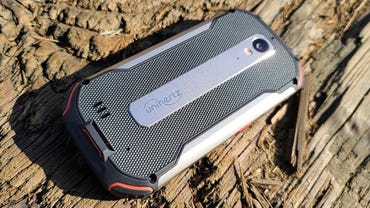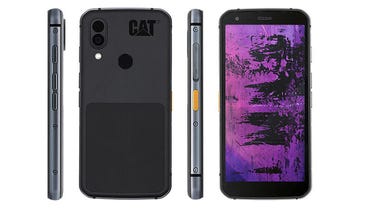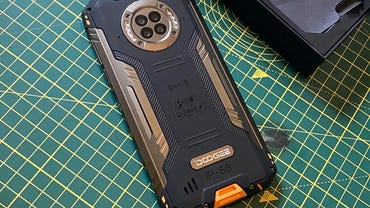Best rugged phone 2021: Your adventure (phone) awaits | ZDNet
Most of today’s modern smartphones are built with glass backs to match the glass display, but all of this glass makes a phone susceptible to breakage if dropped. Phone manufacturers and wireless carriers are more than happy to sell you insurance in case of breakage, but there is another option available to you.
One can pay $50 or more for a rugged case to wrap around your flagship phone. These cases usually come with some level of drop protection (6ft to 13ft), but even with such a case, this case/phone combination has not been put through the MIL-STD 810G range of tests that we find in nearly every rugged phone on this list.
It’s also interesting to note that most of these rugged phones are much more affordable than flagship phones as they are built to get work done and not outfitted with high-end cameras and other advanced technology. Given their price and utility, these options are great to designate as work or outdoor adventure phones while you keep a flagship around to pop your SIM card in when you want the latest and greatest in mobile technology.
The glass displays in phones are the weak link and even with these rugged phones that is one area susceptible to breakage. The material around the display is integrated into these phones so there is a better chance of screen survival on these phones, but if they do break then you are out less money than if your flagship phone suffered a cracked display.
The following phones are all designed to withstand the elements with high IP ratings for dust and water resistance, in addition to durability characteristics with phones that meet MIL-STD 810G standards.
Display: 6.1 inches (2,400 x 1,080-pixel resolution) IPS LCD | CPU: Qualcomm Snapdragon 480 | RAM: 4GB | Internal Storage: 64GB | Rear cameras: 48MP f/1.8 wide angle and 16MP f/2.2 ultra-wide camera (117-degree field-of-view) | Front camera: 8MP f/2.0 | Battery: 4500 mAh| Weight: 185g
Rugged phones are built to withstand the elements of field work and with the new Kyocera DuraSport 5G UW we get the additional support of Verizon’s 5G network. This phone just arrived in our hands and we are working on a full review. It’s much sleeker than the DuraForce Ultra that Kyocera offered previously for Verizon customers.
The Kyocera DuraSport 5G UW, priced at $579.99, is powered by a Qualcomm Snapdragon 480 processor with 4GB of RAM, 64GB of internal storage, two rear cameras, 6.1-inch IPS LCD Gorilla Glass 6 display, and a large capacity 4,500 mAh battery. It supports wireless charging so you don’t need to remove the bottom USB-C port plug to top it off.
The phone is designed to withstand the elements and rough handling with IP68 dust/water resistance, MIL-STD 810H shock test certification, and action overlay data designed to enhance your outdoor adventures.
Pros:
- Slim, sleek form factor
- Reliable rear fingerprint sensor
- Affordable price for a rugged work phone
- Two-year Kyocera warranty
Cons:
- Limited RAM and internal storage
- Android 11 OS
Samsung Galaxy XCover Pro

Display: 6.3 inches (2,340 x 1,080-pixel resolution) | CPU: Samsung Exynos 9611 | RAM: 4GB | Internal Storage: 64GB with microSD | Rear cameras: 25MP f/1.7 wide angle and 8MP f/2.2 ultra-wide camera | Front camera: 13MP f/2.0 | Battery: 4050 mAh | Weight: 218g
Unlike bulky rugged phones of the past, the XCover Pro has dimensions that match other standard smartphones while offering better protection from the elements and accidents. It’s powered by a Samsung Exynos 9611 processor with a 6.3-inch display, dual rear cameras, and more.
Rugged features include MIL-STD 810G 1.5m drop test certification, IP68 dust- and water-resistant rating, a large capacity 4,050mAh removable battery, and Pogo Pin support for accessories.
It also supports Push-To-Talk with upcoming support for Microsoft Teams.
Pros:
- Sleek, rugged design
- Affordable price
- Customizable hardware buttons
- Capable dual rear cameras
- Removable battery and microSD card slot
Cons:
- Limited RAM and internal storage
- Samsung DeX not supported
Display: 4.0 inches (1,136 x 640-pixel resolution) | CPU: MediaTek Helio P60 | RAM: 6GB | Internal Storage: 128GB with microSD | Rear camera: 48MP camera | Front camera: 8MP | Battery: 4,300 mAh | Weight: 224.5g
The Unihertz Atom XL is an affordable, capable rugged phone and a unique aspect of this Android smartphone is that it is tiny, so it fits well in a pocket out in the field.
A 4-inch display is present on this phone that is powered by Android 10 with 6GB of RAM and 128GB internal storage. It has an IP68 rating along with MIL-STD 810G certification. A 4,300mAh battery keeps the phone going all day long, too.
The Unihertz Atom XL also supports Digital Mobile Radio (DMR) so you can use the phone with the included antenna as a walkie-talkie when there is no cellular connectivity available. This is a great feature for those working or playing outdoors.
Pros:
- Small size
- Affordable price
- Multi-day battery life
- Stock Android software experience
Cons:
- Basic camera performance
- Software updates are limited
Display: 3.1 inches (720 x 716-pixel resolution) | CPU: MediaTek Helio P70 | RAM: 6GB | Internal Storage: 128GB with microSD | Rear cameras: 16MP camera | Front camera: 8MP | Battery: 4000 mAh | Weight: 216g
The Unihertz Titan was a very large rugged phone with a QWERTY keyboard, but it was just too large for practical daily usage. Unihertz launched a small model, the Unihertz Titan Pocket, that appears to be a rugged BlackBerry Bold.
Some people in the field prefer to enter text on the phone with a physical keyboard and the Unihertz Titan Pocket provides a QWERTY keyboard for a very reasonable $299.99 price.
A 4.5-inch display is present with 6GB of RAM, 128GB internal storage, and a 16MP rear camera. It is a hefty phone at 303g, but if you want a BlackBerry-esque keyboard then this is the phone for you.
Pros:
- Physical QWERTY with trackpad capability
- Affordable price
- Long battery life
- IR, NFC, and FM radio
Cons:
- No water resistance
- Display too small for aging eyes
- Mediocre camera performance
Display: 5.7 inches (2,160 x 1,080-pixel resolution) | CPU: Qualcomm Snapdragon 660 | RAM: 6GB | Internal Storage: 128GB with microSD | Rear cameras: 12MP f/1.8 with Lepton 3.5 FLIR camera | Front camera: 8MP | Battery: 4000 mAh | Weight: 248g
One great function we have seen in some CAT phones is support for thermal cameras. A thermal camera is a perfect tool for fieldwork, whether scanning for hot spots in a switchboard or seeking them out in an emergency.
The CAT S62 Pro has a 5.7-inch display with glove mode, IP68 dust/water resistance, MIL-STD 810H drop test up to 1.8 meters, and more. Android 10 is present with a Qualcomm Snapdragon 660 processor. It’s priced at $649.
The FLIR Lepton 3.5 thermal camera is the star of the show with the ability to measure temperatures between -20 degrees Celsius and 400 degrees Celsius.
Pros:
- FLIR Lepton 3.5 thermal camera
- Fully rugged (IP68/69 and MIL-STD-810H)
- Not large and bulky
- Solid battery life
- Enterprise-ready features
Cons:
- No air quality sensor or distance tool from S61
- Mid-range performance
Display: 2.8 inches (640 x 480-pixel resolution) | CPU: Qualcomm Snapdragon 215 | RAM: 2GB | Internal Storage: 16GB with microSD | Rear cameras: 5MP | Front camera: 2MP | Battery: 2000 mAh | Weight: 224g
The CAT S22 Flip is available exclusively from T-Mobile for $234 and provides LTE connectivity with the carrier. It’s an interesting phone that harkens back to the day when flip phones were the standard for mobile phones. CAT takes things further with a full 2.8-inch touchscreen display on the top and Android GO 11 powering the user interface.
The CAT S22 Flip is not designed to take on the Apple iPhone or Samsung Galaxy world, but it provides a good option for the intended market segment. It has been reliable, has good battery life, performed well with calls, and provided access to all the information I needed outside in inclement weather conditions.
This phone may appeal to people just with its extremely rugged build and flip form factor, even if they don’t use all of the functionality in the Android OS. It’s a solid phone for basic communications and can even serve as a Wi-Fi hotspot if you have a rugged tablet to connect for more extensive work in the field.
Pros:
- Rugged, classic flip design
- Large tactile keypad buttons
- Removable battery and microSD
- Affordable price
Cons:
- Chunky phone
- The battery is a bit small
Display: 6.22 inches (1,520 x 720-pixel resolution) | CPU: MediaTek Helio G90T | RAM: 8GB | Internal Storage: 128GB with microSD | Rear cameras: 48MP main, 20MP night vision, 8MP ultra-wide, and 2MP depth | Front camera: 16MP | Battery: 6350 mAh | Weight: 308g
The phones in this list all have rugged build, but one thing that sets this model apart is the night vision camera that captures black and white photos when there is no light source. It can be useful for some people working in the field while the rest of the world sleeps.
The Doogee S96 Pro is built like a tank with a massive 6,350 mAh battery to power you for days. It supports 24W fast charging and wireless charging too. We usually see compromises in RAM and storage with these rugged phones, but the S96 Pro has 8GB of RAM and 128GB of internal storage with support for a microSD card.
5G is not supported with this phone, but it works well with T-Mobile in the US.
Pros:
- Massive battery capacity
- Unique night vision camera
- Very affordable price
- High-level rugged design elements
- NFC for Google Pay
Cons:
- Limited software updates
- Lower resolution display than most
How did we choose these rugged phones?
The process to make our smartphone selections includes testing the phones for weeks, reading reviews from other websites and publications, researching reviewer guides and manufacturer websites, talking with colleagues and other users who have hands-on experience with the smartphones, and then selecting the best from all of the available choices.
Which rugged phone is right for you?
All of these phones are powered by the Android OS so there’s no choice on the operating system. If you are reading this list then we assume you are interested in rugged phones that can survive drops, dunks in the water, and are built to get work done out of the office.
The first thing to look for is the unique element in the phone that may be specific to your work. For example, do you need a FLIR thermal imaging camera, a night vision camera, or a phone with a QWERTY keyboard. Check over the unique features and see if any apply to your needs.
The next thing is to check the price since these rugged phones range from just over $200 to nearly $700 so price is a major factor.
Which one is your personal favorite?
I’ve enjoyed testing most of these phones, but I keep coming back to the Cat S62 Pro because of its thermal imaging camera capability. For my specific work needs this is useful and something that stands out from the rest of the phones.
I also enjoy using the Unihertz phones because they are very affordable and have performed well, but they are a bit bulky and I look forward to seeing a future Unihertz model that is sleek like the Kyocera DuraSport.
For all the latest Technology News Click Here
For the latest news and updates, follow us on Google News.





